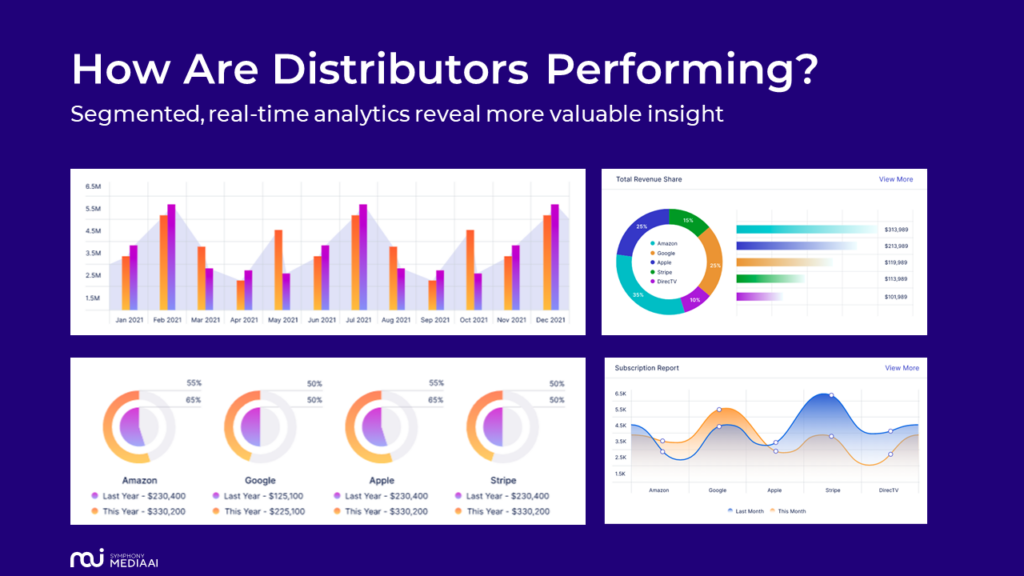This blog will explore the content licensing rights and compliance elements of today’s video experiences and how the power of analysis and automation can dramatically improve an organization’s performance and efficacy.
For any content asset an organization holds, its legal and compliance teams make hundreds of decisions about content licensing rights, long before a single frame of video is rendered on the viewer’s device: where and how it can be viewed, how much distributors and customers will pay for it, how well it will perform on Amazon Prime Video versus Comcast versus SlingTV, etc. In short, content licensing rights are the terms for distribution set by the content owner.
 For content offered on a free ad-supported television (FAST) service, an auction has occurred, and prospective advertisers have paid a fee for their ad to appear in a certain position within that stream. If it’s offered on a subscription-based video on-demand (SVOD) service, agreements have been made that govern which titles will be made available at which times. If it’s a theatrical release, a promotional window has been defined for one or more services to offer the content to viewers.
For content offered on a free ad-supported television (FAST) service, an auction has occurred, and prospective advertisers have paid a fee for their ad to appear in a certain position within that stream. If it’s offered on a subscription-based video on-demand (SVOD) service, agreements have been made that govern which titles will be made available at which times. If it’s a theatrical release, a promotional window has been defined for one or more services to offer the content to viewers.
Once initial negotiations are complete, legal and compliance teams are responsible for continuously re-negotiating, tracking, protecting, and enforcing intellectual property rights and contractual obligations. The volume of content in circulation today, along with complicated distribution and revenue models, only add to legal and compliance teams’ workloads.
The decision matrix and data processing involved in video distribution are just as complex (and vital) for legal and compliance teams as they are to production, distribution, and technical teams. But only the latter functions typically use sophisticated software that can automate workflows, data management, and decision-making.
So why are legal and compliance teams in the media and entertainment industry still relying on a mess of manual processes, legacy tools, and sheer willpower to get their jobs done?
Content Licensing Rights Challenges in Today’s Media and Entertainment Landscape
There are three primary reasons why legal and compliance teams need better solutions to manage licensed content distribution today.
1) Agreement terms are complex.
Media and entertainment content licensing models are fragmented. Managing traditional subscription-based linear TV and digital distribution is relatively straightforward when compared to the diversity of content and platforms we see today (FAST, AVOD, PVOD, and so on).
There are more distributors for content rights holders to manage. Over 300 streaming video services are available in the U.S. alone; a figure that’s doubled in five years. That number is increasing as niche players and traditional pay TV providers bring new solutions to market. There’s also more video content being created, but existing content doesn’t just disappear. Catalogues are growing.
Distribution terms are changing, too. Rather than negotiate agreements that govern entire partnerships or series, video content rights holders and distributors are opting for shorter deal terms that can be more frequently re-negotiated based on variables like distributor revenue performance and direct-to-streaming film release windows. Contracts are being amended, rewritten, or outright overhauled every day.
Consequently, legal and compliance responsibilities – managing multiple agreements, negotiating exclusivity, and monitoring and auditing distributors – have drastically increased.
2) There’s too much data to manage.
The volume and complexity of data that legal and compliance teams must manage is overwhelming. Unlike business functions that deal in structured, numerical data (think finance reports), legal and compliance teams often deal in unstructured, textual data (think agreement clause language). Words are data, too. They can be organized, searched, and analyzed just like any other data sets. It’s just more difficult.
 There are also more business stakeholders seeking access to information that only legal and compliance teams can provide. Consider a content licensing team negotiating their first AVOD deal with a distribution partner that’s previously licensed content for its SVOD service. Where do the salespeople turn when they want to understand that distributor’s audit track record and historic performance trends? Compare potential AVOD and historic SVOD agreement clauses? Calculate potential deal value?
There are also more business stakeholders seeking access to information that only legal and compliance teams can provide. Consider a content licensing team negotiating their first AVOD deal with a distribution partner that’s previously licensed content for its SVOD service. Where do the salespeople turn when they want to understand that distributor’s audit track record and historic performance trends? Compare potential AVOD and historic SVOD agreement clauses? Calculate potential deal value?
Legal and compliance teams are on speed dial to provide more and more insight to the rest of the organization. They’re the gatekeepers of valuable data that’s critical to the success of any media and entertainment business today.
3) Current tools are out of date.
Often, legal and compliance teams are trying to answer pressing business questions and execute their daily job responsibilities by piecing together information across spreadsheets, document versions, emails, and multiple software systems. It’s slowing down the business, from contract approvals that could expedite revenue recognition to audit schedules that could reveal revenue leakage.
The hidden cost of legacy tools is too high to ignore.
The same team that managed 10 distribution partners last year may be expected to manage 20 this year, with multiple agreements in place per distributor. Or series. Or title. Or any number of other variables. That reduces the amount of time available to detect anomalies in, say, payment reports that could signal the need for an audit.
For each of the scenarios mentioned above, legal and compliance teams trying to collaborate across scattered file servers and locations risk more than operational efficiency; when demand exceeds organizational capacity in a fast-paced environment, even the most scrupulous employee is prone to human error. That’s not a risk most media and entertainment companies (or attorneys whose credibility hinges on the accuracy of their work) can afford to take.
How Software Improves Legal and Compliance Data Management and Workflows
Before we dive into the benefits of modern software for legal and compliance teams, let’s set a baseline on data management best practices. In order to valuable, data must be accurate. Insights extrapolated from that data must be explainable, defensible, and without conflict or doubt.
It is one thing to manage data effectively and with integrity, but it can (and does) take a lot of human power to carry out the work. Legal and compliance professionals aren’t typically trained in data analysis, but they are increasingly responsible for providing counsel that depends on high-quality, data-driven insight.
Legal and compliance functions will always remain a critical human function in media and entertainment. But software can drastically expedite workflows, often decreasing the time it takes to analyze and report on data from days to hours.
Tools like Revedia enable legal and compliance teams to take advantage of automated data management and analysis without the need for data expertise. Here are some of most common processes that legal and compliance teams automate with modern software.
- Data normalization creates consistency among diverse data sets. Unstructured, qualitative, and non-standardized data – like distributor reports that come in 100 different formats – is hard for both humans and software to process. Solutions that automate data normalization enable legal and compliance teams to centralize and analyze data living in siloed systems (file servers, audit logs, even desktop folders). This process can both eliminate error-ridden manual data entry and scale the amount of insight that data can provide.
 Distributor management means more than just exercising audit rights. To really understand a licensing partner’s value, content rights holders need to think strategically. How is compliance trending over time? Is there a consistent pattern in the audit findings? Aggregated data and automated analysis can answer these questions in a fraction of the time it would otherwise take. Automation gives legal and compliance teams the ability to review financial and audit data, compare findings by time period, and identify recurring issues.
Distributor management means more than just exercising audit rights. To really understand a licensing partner’s value, content rights holders need to think strategically. How is compliance trending over time? Is there a consistent pattern in the audit findings? Aggregated data and automated analysis can answer these questions in a fraction of the time it would otherwise take. Automation gives legal and compliance teams the ability to review financial and audit data, compare findings by time period, and identify recurring issues.- Cloud-based agreement management puts distributor documents in a single, access-controlled location where stakeholders can quickly search keywords, control file versions, compare clauses, and even integrate other team’s data. Rather than legal requesting finance’s latest figures ad hoc, both teams can access a single source of truth. This improves collaboration and data security.
- Event tracking and notifications help legal and compliance teams know ahead of time what’s up for renewal, what’s expired, and when. Automated notifications for events such as audit dates, easy-to-understand approval queues to manage associated tasks, and centralized access to relevant documents mean that teams can focus on doing their work, instead of managing the volume of work they have to do.
Compliance and Security Are Critical to Successful Workflow Automation
Legal and compliance teams aren’t only protecting content licensing rights. They are there to help maintain organizational integrity.
Though certainly not unique to media and entertainment, adherence to standards dictated American Institute of Certified Public Accounts (AICPA), such as service organizational controls (SOC), and internal protocol is mandatory. Reputable service and solution companies invest in both SOC 1 Type II and SOC 2 Type II at least annually.
SymphonyAI Media clients know that compliance lies at the heart of our business. We work with a third party to certify and issue reports that fully validate what we do for each of our media partners. This includes, but is not limited to, an overview of operations, control environment, how we manage risk, how we manage and control activities involving data and financial information, system operation, backup and recovery, as well as physical security.
Software Makes Legal and Compliance More Valuable to Media and Entertainment Companies
Recently, a client of ours conducted an audit of a major distribution partner. Using automated data analysis, the Revedia platform detected a significant number of under-reported subscribers and views across the audit period. Given that both our client and their distributor are publicly traded companies, the impact of the insights our software generated was material to their earnings reports. Fortunately, our client and their distributor were able to proactively issue statements addressing the situation.
Software helps mitigates the risk of such dramatic scenarios, but it’s just as valuable in its ability to complete everyday tasks faster and more thoroughly than humans alone. With the myriad of tasks to be done, legal and compliance teams can leverage software to plan, prepare, and execute their work more effectively – and create more value for their organizations in the process.


